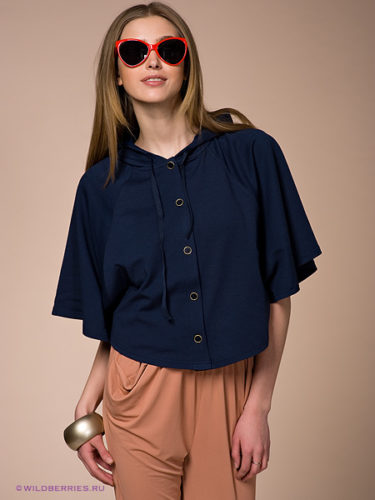Blue top and bottom. Color wheel and the correct combination of blue in clothing
Every season, designers offer certain fashionable colors in clothing.
The site Shtuchka.ru will tell its readers today about how to wear navy blue who it suits best and what dark blue things are best for blondes and brunettes to wear.
Alternative to black
Classics are always relevant. This applies best to blue fabrics. All its shades slim the figure and look very elegant. Dark blue is no exception, which can be worn with a large number of other colors. Indigo, as it is also called, gives organization, efficiency, calls for order and concentration. Unlike black, there are no sad notes in it - on the contrary, it is smart, positive and mysterious.
This color is obtained from a mixture of cobalt, ultramarine and black, so all its shades have a deep and pure blue. Although it is a basic one, when choosing it you should follow some rules:
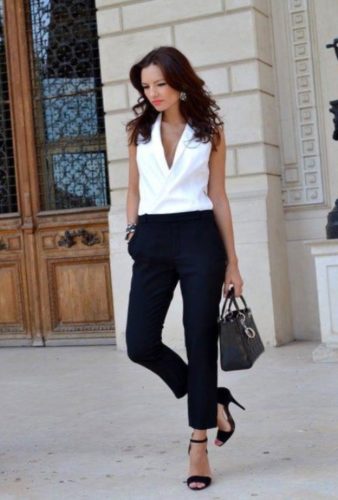
This amazing color looks perfect both alone and in combination with other colors. All shades of white can be called its constant companions. This duet is suitable for office wear, going to the theater, or going to a concert. Bright colors (red, fuchsia, raspberry, lemon, orange) will create the mood for a club party or disco.
What to wear with dark blue?
Now let's look at each individual case in more detail. If you decide to purchase outerwear in this color, then pay attention to accessories. Cashmere coats, raincoats, windbreaker jackets will look advantageous if they are complemented with scarves and scarves in contrasting shades: scarlet, beige, pink, etc. You can wear a fashionable dark blue down jacket or coat with padding polyester with additions of natural or faux fur.. advises wearing a strict skirt and skinny jeans. A large bag, high-heeled boots, a small hat or beret will help complete the look.
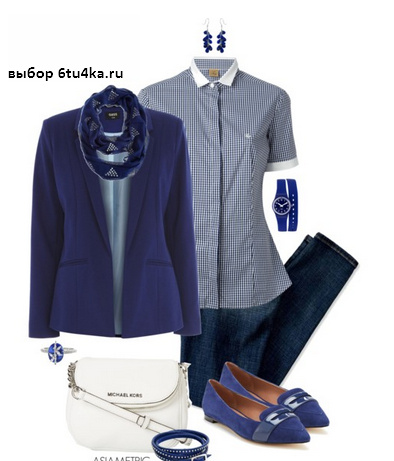
You can wear a dark blue jacket almost always and with everything!
Jackets, blazers, knitted cardigans Pair with golf sweaters in calm or bright colors. If you need to put together an outfit for the office, then add a black pencil skirt and pumps. A bright red dress and clutch to match the top would be a bold combination. If you want to create a look in retro style, then use a blue shirt with a turn-down collar and skinny jeans. The look will be completed with a hat, a small beret or a headscarf. For lovers of casual style, we recommend loose-fitting white trousers, a white blouse and a tie that matches the color of the jacket. A dark blue top can also be worn with things that have a small print or stripes - the main thing is to maintain the color scheme.
Dresses These shades can come in a variety of cuts. A sheath dress made of knitwear or jersey is suitable for work. Underneath it, wear beige or black tights, ankle boots, and pumps. Add small jewelry (pendant, brooch) to make the look less severe.

You can wear a dark blue dress as a casual dress, creating both formal office and casual looks.
A dark blue outfit can also be worn as evening. Sew yourself such a dress from flowing satin, natural silk, guipure, organza, chiffon and become the queen of the ball. It can be any length, curvy or figure-hugging - this color always looks advantageous. Small rhinestones, elegant gold or silver jewelry, and belts are suitable additions. Choose high-heeled shoes - black, white, beige.
Blouses Indigo colors can replace a business jacket. A beautiful romantic cut, complemented by a bow, in combination with a narrow skirt or classic trousers will add elegance and at the same time will not go beyond the busines style. Bottom color – white, beige, black, red. For everyday wear, choose loose-fitting shirts and complement them with shorts, breeches, long skirts, and jeans in bright colors. In this case, it all depends on your taste preferences.
Skirts and trousers They are perfect not only for creating a business style, but will also give you the opportunity to experiment in different directions. For summer fun, add a striped top. T-shirts, T-shirts, tops with blue and white stripes - and now you have an outfit in the popular nautical style. Multi-colored prints will give a positive look to your look. You can throw a jacket, a light jacket, or a poncho over it. The bottom of this color is also very practical - you don’t have to be afraid of getting dirty on a walk outside the city.
If you doubt that this color suits you, then try using accessories. For example, neckerchief or silk scarf. This addition to outfits in white, yellow, red, and peach colors will certainly add an original touch. Boots, bags, gloves - all this will help you create impeccable options and new looks.
Natalia Viktorovna – especially for the site Shtuchka.ru
Fashion surrounds us everywhere, and sometimes it seems to us that its whims are completely random. However, modern psychologists, sociologists, anthropologists and cultural historians will not agree with this. For representatives of these scientific disciplines, fashion is an entire communication system with the help of which a person or group of people communicate important information about themselves to others. And if fashion changes, it means that society is going through certain changes. In a series of articles, we decided to focus on different aspects of fashion, and for simplicity, focus on fashion in clothing. Today we will talk about the role that color plays in choosing clothes.
Since time immemorial, people have been wearing clothes of different colors not only for the purpose of decoration. Color is a sign system that can still be used to this day for the purpose of one’s own social identification. The choice of clothing color is almost never accidental. It is influenced by many factors, ranging from the ability of people of a particular culture to distinguish certain colors, to the hierarchy of colors in a culture and the characteristics of the psychological perception of colors. Let's try to figure it all out.
Sea of Wine
Although the ability to distinguish colors is given to people at a biological level, not all people do it in the same way. About what's in between different cultures in the perception and interpretation of certain colors, linguistics tells us. IN different languages There are from two to eleven so-called color categories, each of which includes one base color and many of its shades. For example, a full set of categories is available in Russian and most other Indo-European languages (black, white, red, green, yellow, blue, pink, gray, brown, orange and purple), but in Darkinyung, one of the Australian Aboriginal languages, there are only two words for individual colors - black and white.
It is also well known that the ideas of speakers of different languages about the same color may not coincide. Thus, in the Russian language there are two separate words - “blue” and “blue”, unlike many Germanic languages, where the range of colors of one part of the spectrum is characterized by a general designation like the English “blue”.
At the same time, the addition of words denoting colors to the language follows a stable pattern, violations of which have never been recorded by linguists and anthropologists. It all starts with two words, "black" and "white", then adds "red", then "yellow" or "green" and so on. According to a number of studies, “blue” is one of the last words to appear in the language for basic colors.
There is no word defining this color in such ancient languages as Greek, Chinese, Japanese, Hebrew. When Homer composed his poems, he called the sea “wine-colored.” The greatest contribution to the study of the phenomenon of the absence of flowers in some ancient cultures was made by Lazarus Geiger in his study “Ursprung und Entwicklung der menschliehen Sprache und Vernunft”. Geiger notes that neither in the Vedas, thousands of lines of which are devoted to events in heaven, nor in the Bible, where heaven is mentioned 430 times, was the description of heaven ever provided with a color epithet.
Continuing his research, Geiger discovered that in older sources, for example in the Rig Veda, there was no mention of the color green. Perhaps the Egyptians were the first to coin the word “blue” - the color was associated with the god Amon-Ra, numerous portraits of the kings of the 18th dynasty with blue faces symbolically reflect their likeness to this god, and the word itself has four spellings in hieroglyphs.
“Portrait of a Young Sculptor”, Agnolo Bronzini, 16th century (Louvre)
Anthropologists agree with linguists: human color perception begins with three primary colors: black, white and red. These colors are fundamental to all peoples - it seems that all ancient societies recognized their symbolism. According to research by John Baines, even the words for them are similar across different language families. Why are black, white and red universally vital colors? The assumptions that exist in this regard are varied, but today the theory put forward in the book by art historian Manilo Brusatin, The History of Colors, has prevailed, according to which they are the colors of shadow, light and life (blood).
The color black is universally a symbol of death, division or submission. For the Hausa culture in Nigeria, Sudan, Cameroon, Ghana, Ivory Coast and Chad, black denotes negative and socially undesirable qualities and things that harm a person. White is a symbol of purity and “all that is good”: with the help of white you can banish evil and to ward off trouble, even the dead were buried in white clothes as a sign of purification. The Hausa believe that white is a symbol of desirable things, and the word "white" in their language is used for a positive characteristic: to have a white heart, to be just and noble, to have a white one. blood to be popular, to have a white belly to be happy.
Legendary Color: Black
Everyone is familiar with the usual interpretations of the color black: depression, mourning, mysticism, evil. In Europe of the 16th century, a black suit not only expressed grief, but was also a weapon of “mods.” Black signified “anti-fashion” for the elite and served as a way to frame oneself like a painting.
Thus, the nobility, dressed in black, stood out effectively against the background of the general diversity. Catherine de Medici, who attracted attention with her ostentatious mourning; Duke of Burgundy Philip the Good, who appeared at the ball in a black suit, was the first swallow to appreciate the possibilities of this color. Around this time, El Greco painted Portrait of a Man in Black - an example of how color can highlight a person and give him deep expressiveness.
Black color became fashionable with a touch of luxury in 1926 thanks to Coco Chanel. In the 1960s, Marlon Brando's black leather jacket became the personification of the spirit of freedom, the underground, and youth protest. In the 1970s, Yves Saint Laurent introduced black as universal, and the 90s, with the cult of Japanese designers, made the color synonymous with intelligence and artistic glamour.
Now black in clothes is a universal code for bohemians. This neutrality is often occupied by fashion designers: Karl Lagerfeld, Tom Ford, Marc Jacobs, Alexander Wang and others. All of them appear in public exclusively in black.
Jewish tradition states that the name Adam means "red" and "living", and Slavic languages use the word "red" to describe beautiful things. In China, sacrificial vases associated with the cult of death are decorated with red; red there is a symbol of ghosts and the other world, just like among the Navajo tribes.
To understand how these preferences develop, scientists have focused on evolution. The generally accepted theory is that we like colors that are associated with healthy and pro-survival things. For example, a blue sky indicates calm weather, which may explain why blue is the color of choice in clothing. On the other hand, rich yellow tones are associated with yellow bile, which, according to Aristotle, spoils character.
As expected, blue and yellow are at opposite poles in almost all studies around the world. This was reflected in many languages, including Russian: yellow house (hospital for the mentally ill), yellow ticket, legalizing the activities of prostitutes in Russian Empire, yellow press, yellow fever. Yellow is the color of poverty, suffering and illness. It is he who is most often mentioned in the novel “Crime and Punishment” - Dostoevsky often resorts to him to describe the appearance of the characters: there are many “pale yellow” faces in the novel, the “yellowed fur jacket” of the old money-lender, yellow wallpaper in her apartment, Raskolnikov's closet, in Sonya's room, in Porfiry Petrovich's office.
It turns out that symbolic meaning is given to various colors by emotions associated with what these colors represent. Therefore, in any culture, color is not a symbol in itself, but the personification of a symbol, just as the color red represents blood, which, in turn, carries a lot of symbolic meanings in itself.
World religions played a special role in the development of this color symbolism. Thus, the Christian Church accepted green as a symbol of new life, replacing red with it, and giving white a new meaning - holiness and innocence. Blue replaced the pagan meaning of white as the color of prosperity and health. As Brusatin notes, blue and green began to personify monotheism. Islam followed Christianity in its color symbolism, adopting green as a symbol of religion and the prophet and blue as the color of a new community of true believers.
But the role of color designations in a particular culture is also influenced by other factors: natural phenomena, social hierarchy, everyday realities. Thus, the Maori peoples in the deserts of New Zealand distinguish hundreds of shades of red, the Inuit language of the Arctic has seven designations for shades of white, and modern Europeans living in cities distinguish at least a hundred shades of gray.
Yellow pants
Color as personification symbolic meaning Already in ancient times, it played an important role in the coloring of clothes. This role could be purely functional - for example, in Scotland, each clan traditionally had its own color and design of the kilt, from which, like a passport, one could read information about its wearer. In China, orange robes were traditionally worn by those condemned to death.
For many ancient and medieval peoples, the color of clothing was part of hierarchical characteristics. A striking example is India, where historically, along with the caste system, ideas about the colors inherent in different segments of the population were introduced - in fact, the word “varna” (aka “caste”) literally means “color”. By white clothing one could recognize a learned brahmana, by red clothing a kshatriya warrior, by yellow clothing a farmer or merchant, and by black clothing a sudra or servant. Of course, in modern India, the rules of color differentiation are observed only in the families of traditional nobility, but everyone is well aware of the symbolism of a particular color. By the way, this is why the traditional exhibition of fashion collections for Indian designers - Amazon India Fashion Week - is so poor in black.
In turn, in medieval Japan, the colors of clothing of different classes were associated with the art of dyeing “bingata” fabric. Very bright colors and silk - these two attributes of clothing are characteristic of the Japanese nobility, while representatives of the lower strata wore dull cotton and abaca (fabric made from banana palm fibers). Only members had the right to large and bright designs on clothes imperial family, and only they in all of Japan could appear in yellow outfits. The aristocracy was allowed light blue and white clothes.
Legendary color: pink
Rich people's casual clothes are now seen as understated (unless they're walking the red carpet). This is due to the fact that wealthy people, as a rule, wear clothes made from natural fibers, the dyeing of which rarely produces a bright color, but most importantly, modern ethics dictates that they should not stand out, thereby emphasizing that they regard their own wealth as an ordinary fact.
At the same time in modern world colors play an important role in demonstrating political beliefs - just remember, for example, the role of red for left-wing movements of all stripes, from the red flag of socialists and communists to the radical Red Brigades or the Red Army Faction in Europe in the 70s and 80s of the last century. On the contrary, black is the color of right-wing radicals, from Italian fascists to the Greek Golden Dawn, as well as anarchists. Blue is preferred by moderate conservatives - it is not for nothing that Tory representatives wore boutonnieres and ties of this color, from whom they passed on to the current Conservative Party of Great Britain.
One study found that top students at the American University of Berkeley considered red and white, the symbols of their rival Stanford University, the most disgusting colors. And Stanford people, in turn, cannot stand blue and gold - the colors of Berkeley.
Through colored glasses
As rigid class differences in Europe, and then in the rest of the world, became a thing of the past, the color scheme of clothes became more and more variegated, and preferences in the choice of colors became more and more flexible. People no longer thought about political symbolism or the social content of colors, but about their influence on the nervous system of people, that is, about the psychology of color.
The first observations in this area, as usual, belonged to artists, poets and writers. Thus, Goethe, in accordance with the original color theory he developed and depending on the type of works being created at a given moment, used glasses with lenses painted in different colors. The writer argued that red and yellow colors make a person happy and stimulate his energy, while blue color causes despondency, suppresses mood and self-confidence.
The psychology of color in painting and literature received a special impetus simultaneously with the development of symbolism in the second half of the 19th century: having ceased to copy reality according to the laws of external plausibility, focusing on the expression of internal experience, the French impressionists made a revolution in art, opening the way for a whole host of innovators of other directions, including including such recognized masters of working with color as Matisse, Cezanne, Van Gogh and others.
French writer J.-C. Huysmans, the author of the cult novel “On the contrary,” vividly described, in accordance with the “mathematically precise” theory, the predilection of people of different temperaments for strictly defined colors. In England, Oscar Wilde wore a green carnation in his buttonhole and dressed in suits of incredible shapes and colors to emphasize the aesthetic subtlety of his nature.
J.-C. Huysmans, "On the contrary"
Des Esseintes chose orange, thereby confirming a theory that he had always considered mathematically accurate: artistic natures are associated with the color they love and highlight.
So, thought Des Esseintes, let us not take into account ordinary people, whose rough eyes will not notice either the rhythm of color or the mysterious charm of its fading and transition from shade to shade; let us exclude the average person who will not perceive the solemn splendor of strong, hot tones; But let’s turn to people who are vigilant, subtle, and educated. In this case, it is obvious that, for example, an idealist, a dreamer, a builder of castles in the air will prefer, as a rule, blue color with all its derivatives, say, lilac, lilac, pearl gray, as long as they do not lose their tenderness, slight uncertainty, just turned purple or gray.
And, in particular, those who like to pursue ladies and in general full-blooded people, dignitaries, big men who despise half-heartedness, fleetingness and rush headlong into everything, they adore bright yellow, and flashy red, carmine, and chrome green. These colors blind and intoxicate them.
And finally, people are sick and hysterical - their sensual appetite asks for something sharp, spicy, and in their overexcitation and weakness, they all, as one, love precisely this irritating orange color, hitting the nerves and full of a ghostly shine.
Per. from fr. E. L. Kassirova, edited by V. M. Tolmachev
Back in the early 1930s, the Indian scientist D. R. Ghadiali described the therapeutic effect that different colors have on the body - in his opinion, the organs and systems of the body are sensitive to certain colors, which stimulate or slow down their action. But “officially” color entered psychology in the mid-1940s thanks to the Swiss scientist Max Luscher, who, in particular, invented a color test for analyzing the state of a person.
Although Luscher's test was based on the hypothesis that color preferences are subjective, the scientist believed that the perception of color itself is objective and universal. Thus, he argued, the color red represents an ergotropic physiological state: it increases blood pressure, increases heart rate and breathing. Red is an expression vitality and the height of vegetative excitation, so it has the meaning of desire and all forms of appetite.
The fact that a woman in red is a coveted stereotype for men is also evidenced by a study by psychologist Andrew Elliott from the University of Rochester. In contrast, dark blue is a color of relaxation and the color expression of the biological need for peace and satisfaction. It is not for nothing that Schelling in his “Philosophy of Art” used exclusively symbols blue and asserted: “Silence is that peculiar state of beauty that is the peace of the serene sea.”

Oscar Wilde. Photo by Napoleon Saroni (1882)
Photo Tractatus/Flickr
Having understood the presence of general trends in the perception of different colors, psychologists began to think about the question of people’s personal color preferences. Karen Schloss and Stephen Palmer of the University of California at Berkeley conducted a series of experiments in which different groups of volunteers were shown color slide shows. The images were biased: One group was shown red objects with pleasant associations, such as ripe strawberries, and green objects with aversive associations, such as slime. Volunteers from another group observed unpleasant images of red color - puddles and blood stains, but pleasant images of green color - tree crowns.
After studying the reactions of the experiment participants, Schloss and Palmer concluded: people prefer the color that in their minds is associated with positive associations, be it red or green.
Thus, experiments by psychologists confirmed many years of observations by linguists, anthropologists, ethnographers and cultural historians: human perception of color is determined by objective biological parameters, but the actual color preferences of different people at different times and different places remain quite flexible, being dictated by countless unique factors.
Consumption palette
But this does not mean that the peculiarities of people’s color perception cannot be controlled. While scientists are struggling to come up with new experiments, marketers have become adept at capitalizing on people's passion for different colors.
Marketing exploits the human associations that arise with a particular color to evoke a certain emotion and influence the attractiveness of a product. Thus, a system of consumer stereotypes has developed in the clothing industry: the elderly are attracted to small ornaments and pastel colors, the impulsive buyer is caught in sharp contrast, consumers of men's clothing are caught in the solidity of dark blue, and online stores selling clothes, as a rule, are decorated in pink or blue tones.
In clothing, the king of colors is blue; it is considered the most pleasant by 57 percent of men and 35 percent of women. At the same time, buyers of things of certain colors, of course, are not familiar with Luscher’s works, but are only guided by a momentary emotional state or pure utilitarianism - for example, black is chosen to hide excess weight, and so on.
Expert opinion
The identification of new color “preferences” at the stage of their inception is carried out by special forecasting bureaus (forecasting agencies), which conduct searches research work and build scenarios for the future development of style, color, and so on. It can be argued that the color trend is truly the result of marketing analytics.
Fashion forecasters identify emerging social changes in society based on the research of social scientists, and then translate these phenomena into specific recommendations for the industry.
Before a product hits the shelves, a forecast of textures and color palettes is drawn up two and a half to three years in advance. An examination of fiber manufacturers is carried out, who develop the structure and texture of future fabrics and demonstrate them at specialized exhibitions and conferences. Further, professional organizations, such as “color forecasting groups,” solve the problem of identifying color preferences that will become widespread in the coming years.
This creates a palette of approximately 250 dyes for fibers of all types and thicknesses. Twenty percent of these dyes are key and do not mix; the rest are later transformed into complex color palettes.
Color forecasts are created by experts in the field of color forecasting, which is the result of analyzing data obtained from a large number of different areas, and the result is a color mood board, which affects first the production of fabric of a certain color and texture, and then specific large brands that decide join the trend.
As a rule, models of the so-called “basic colors” sell well in all brands and at any time: white, black, blue, gray, beige, burgundy. In collections, buyers place the main bet on colors that are guaranteed to sell well. As a rule, they are not afraid to reorder products of these colors, because the surplus that was not sold this season can easily be sold next season precisely because of the color, but provided that the model is quite classic.
Check your wardrobe - regardless of taste and style, you will definitely find T-shirts, trousers, skirts, sweaters, dresses and sweatshirts in these colors, not to mention outerwear.
It’s hard to imagine modern clothing, footwear and accessories stores without visual merchandising technologies. For ease of selection, but primarily for a specific marketing purpose, clothes are hung in the sales area by color - this is done by visual merchandising specialists.
There are several rules for such hanging:
- clothing in the entrance area of the store should continue the color theme of the display windows, so that the buyer immediately finds what attracted him to the display;
- the number of color themes in the sales area depends on the brand and the number of collections developed by designers. Hanging by color themes not only allows customers to find the right product in the required color, but also to create a set (look);
- the sales floor must be “readable” by customers. One color theme should smoothly replace another, which subconsciously motivates the buyer to examine the entire range.
Anush Gasparyan,
Director of the educational center "Management and Communications in the Fashion Industry" of the National Research University Higher School of Economics, Candidate of Sociological Sciences, co-founder of Fashion Consulting Group
In the USA there is an entire organization Color Association of the United States, which carries out marketing research and is an expert in the field of color trends for various market players. Her research is based on medical experiments - for example, the association claims that men and women see colors differently. Men are attentive to small details and sensitive to fleeting impressions, but women are better at distinguishing colors.
According to brain studies, male sex hormones (androgens) are concentrated in areas of the cortex that are responsible for image processing. Androgens are also responsible for controlling the development of neurons in the visual cortex during embryogenesis - men have about a quarter more of these neurons than women. Consequently, men's shirts will still have small stripes, and women's flowing chiffon dresses will be bright and with large flowers.
Another study confirms that men are indeed slaves of blue, and women are slaves of blue and purple. Even if you are not one of the fans of these flowers, alas, you will have to obey what the industry dictates. Marketers have been studying color for years in order to see several steps ahead, and the consumer is happy to learn stereotypes that are broadcast through the media and the lines of ready-to-wear manufacturers. The circle is closed.
So, choosing a color in clothing is a very complex process that involves many people, not just the consumer; There are many factors behind this choice, often not realized by the consumer. That is why, when meeting a person by the color of his clothes, we in advance, even before meeting him, form an impression about his cultural and social background, as well as about the characteristics of his temperament. And as a rule, we are not mistaken.
Sofia Shpilberg
Combinations of white and blue fashionable look considered classic. Discreet but bright blue is rightly called “royal” - not everyone dares to wear such a shade of clothing. White is the color of innocence and purity. Clothes of this color add festiveness and a certain severity to the image. In this article we will discuss the combination of colors in clothes: white top blue bottom.

Shades of blue
Blue color is unique in that it has many shades, each of which differs in its ability to give the image a certain mood.
- The shade of blue “Navi”, despite its saturation, is quite neutral and calm.

- Dark blue is strict and versatile. Equally suitable for creating any image.

- Bright and catchy. Sapphire blue clothes are an excellent option for fair-haired representatives of the fair sex.

- Deep dark blue, almost black. Calm and neutral, but with the right accessories it can be transformed and give the image a unique style.
Office style
Office style is very conservative and strict. An ideal option for office work would be a white top and dark blue bottom. This combination of clothes will help you get into a working mood, but will not look gloomy. A white blouse or shirt will dilute the look, adding a little freshness and lightness to it.

A white shirt and a blue skirt will allow you to visit after a working day gala event, and will look quite elegant. A feminine outfit will make your look very elegant.


A white blouse with blue trousers is also a good option for an office look.


It is not for nothing that blue trousers are considered clothing for basic wardrobe. Any model in this color scheme will look advantageous.

Dresses 2017
2017 is rich in innovations in the fashion world. Among the new items, an unusual and bright white and blue dress will take its place.


The variety of dresses in this color scheme will please any fashionista. Among the popular models you will find an outfit for a special occasion and an everyday look, as well as unusual dresses in a sporty style.
- A vest dress is an unusual option for a summer look. Most often, the model has a fitted cut, but it will look most impressive in combination with long sleeves. When creating an image based on a striped dress, you can choose any shoes, be it comfortable ballet flats or high-heeled shoes; for girls who prefer a sporty style, sneakers or sneakers are acceptable.


- A blue dress with white polka dots takes us back to the distant 60s. A dress in this color scheme will look especially impressive with a full skirt. A red belt will help complement the look; it will look harmonious and add brightness to the image.

- In the coming year, designers are offering fashionistas options for dresses with geometric prints in blue and white. color scheme. For girls with extra centimeters at the waist, white dresses with blue lines on the sides are suitable; this design option will help model the ideal figure. A horizontal zigzag can be an unusual option for a vest dress, but girls with curvy figures are better off avoiding this variation, in principle, just like the usual horizontal stripe.

- A fashionable dress - a white top and a blue bottom can look quite strict and conservative, especially if it is complemented with a turn-down collar and cuffs. A sheath dress will look best in this color scheme. The outfit will be a good option for working in the office or for a high school student.
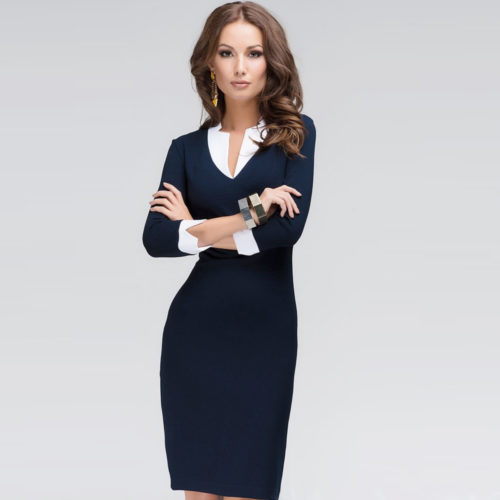
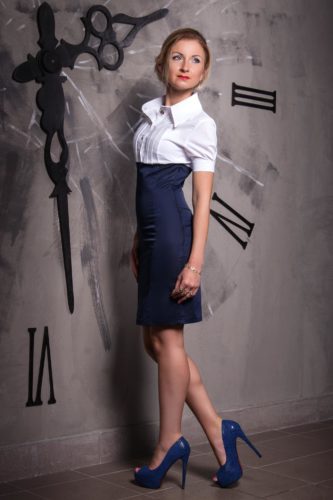
- An evening dress made of white and blue lace will give an image of elegance. The lining of the dress is made of white material, and the lace of blue will create an unusual effect of a dress for a special occasion. As a rule, such an unusual solution does not require additions.
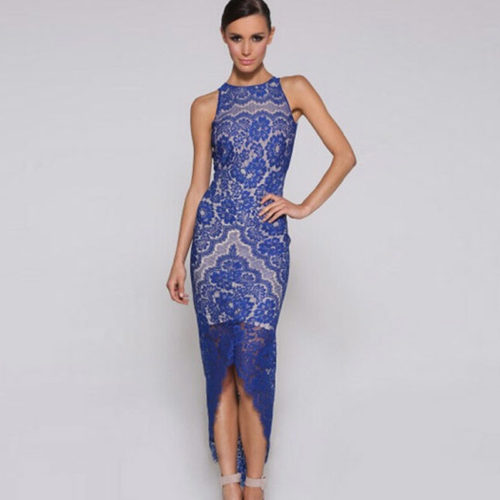
- White top, blue bottom, floor-length dress is a good combination for an evening dress. The sky blue shade of the hem will make the outfit bright, and the white top will add tenderness. Dresses with a smooth transition from a snow-white top to a blue hem will look unusual; an outfit with such a color scheme will be a good option for a summer holiday on the seaside. A long white dress with blue floral prints reminiscent of Gzhel looks very unusual.


White and blue are a great alternative to black and white
The combination of white and blue in clothes is an excellent alternative to the classics of white and black. Thanks to the large number of shades of blue, outfits in this color scheme will look bright and stylish. A girl with any hair color, eye color and body type can easily choose a suitable outfit, since the combination of white and blue suits everyone, regardless of age. Outfits in this color scheme can easily be considered classics. The examples with photos indicated in this article will help you verify this and find suitable options for yourself for all occasions, and most importantly, will allow you to be on top of the fashion wave.
Video on the topic of the article:
A stylish look is 99% made up of the right combination of colors in clothes, makeup, and accessories.
If the colors are combined incorrectly, it creates the feeling that something is “wrong” with the appearance. This is connected not so much with a conscious understanding of the fashionability and stylishness of things, but with the physical laws of color perception.
It works like this:
The gaze glides over the appearance of another person and notes the harmony or disharmony of color combinations. If our eye notices the inharmony of colors, then an irritation signal immediately enters the brain and a reaction of rejection is formed. It is at this moment that we say that a person is dressed ugly. And sometimes we can’t even explain why this is so. In order to look stylish, you must adhere to the natural laws of color combinations and never violate them.
Law 1: Combination of no more than 4 colors
Your image should use from 2 to 4 colors. If you use only 1 color, it creates a feeling of dullness and paleness.

Using more than 4 colors makes you look like a parrot. When people see you, their gaze jumps from one color to another, not knowing where to stop. Unconsciously, this increases people’s anxiety and makes them call your clothes “tacky.”
Law 2: The ratio of colors is not equal:
1 or 2 primary colors + additional colors
Clothes must have a main color, which is larger in area, and some additional colors, which are smaller.

For example, a blue knee-length dress + a blue scarf + black shoes (blue is the main one) blue jeans + a white long shirt untucked + white shoes + a white bag (white is the main one) Keep in mind that not only the color of clothing plays a big role, but also the color of your tights, hair, bag, even the packages you hold in your hands. Those. everything that is currently with you or on you.
Law 3: Black, white, gray go with all colors
Universal colors that can complement any other color are gray, black, white.
![]()
Keep in mind that visually white color expands, black narrows. These colors are best used for basic items, which will then be complemented by bright accessories or colored items. When choosing between red, blue and black shoes, it is better to choose black ones. They will go with everything in your wardrobe
Law 4: All pastel colors go together regardless of shade
Pastel colors are beige, peach, pink, light blue, etc.

Those. all colors that add a lot of white. These colors can be combined with each other in any order. Be careful with pink - the only color that looks fat.
Law 5: The bottom should be 1-3 tones darker than the top (except for white)
An important rule is one that allows you to visually make your figure lighter and slimmer. Classic - white top, black bottom.

The base (bottom) should be stronger, more stable, and therefore darker. The top should be lighter, more transparent, lighter. Like for example a tree that has a brown trunk and light green leaves. Breaking this rule makes you look like an inverted triangle.
Law 6: Combine related or contrasting colors
You can combine either related or contrasting colors with each other. All other options are inharmonious. Related colors are colors that differ from each other in shade (red, pink, dark red)

Contrasting colors are colors that are completely opposite (purple-yellow, blue-orange). The only contrasting combination that, in my opinion, is risky is green and red.
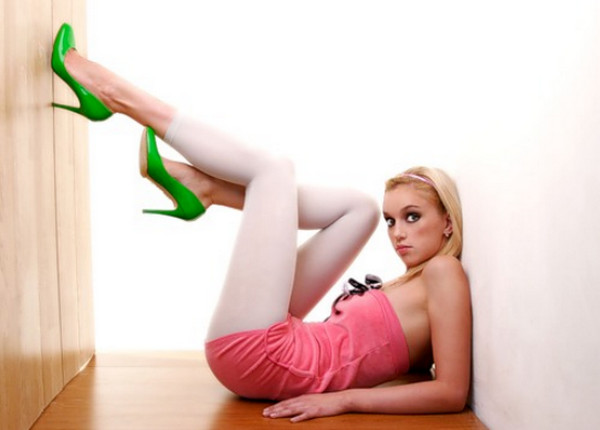
You can find out which colors are related and which are contrasting using the color wheel.

You've probably seen that many designers deliberately break these natural color rules. They do this on purpose: for example, to make the image of the collection more aggressive, shocking, bright and extravagant, 10-15 colors are used in clothes.

You too can break the color rules, but you must be 100% sure of the message you want to convey to the people around you.
author Ekaterina Kulakova

